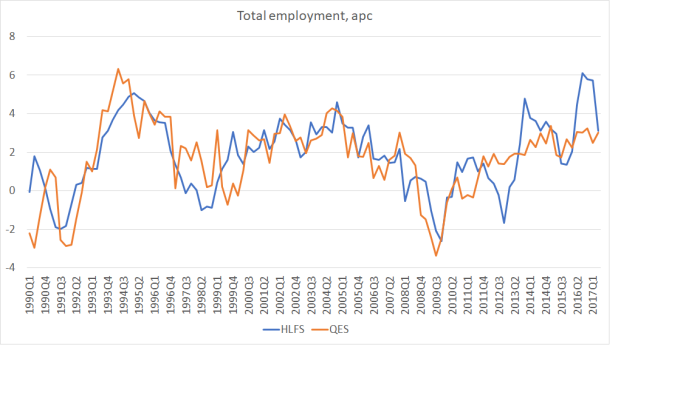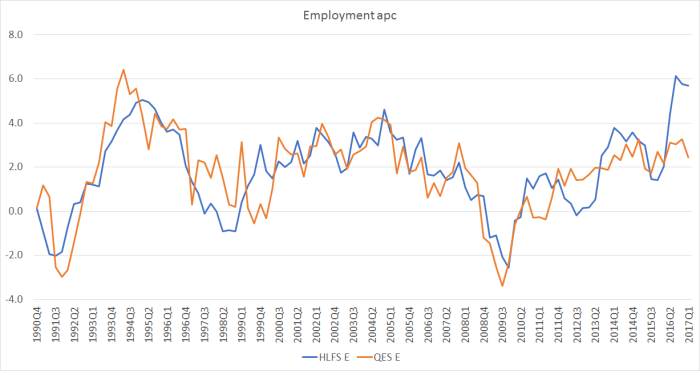There was another post on Kiwiblog this morning, attempting to cast New Zealand’s recent economic performance in a particularly good light. Here was the bit that really caught my eye:
this is not just exceptional job growth locally, but internationally. Here’s the percentage increase in jobs in major OECD countries in 2016:
- NZ 5.7%
- Germany 2.9%
- Ireland 2.9%
- US 1.8%
- OECD 1.6%
- Australia 1.6%
- Sweden 1.5%
- UK 1.4%
- Canada 0.7%
- France 0.6%
- Finland 0.5%
Now there are at least three problems with this comparison:
- it makes no allowance for the much more rapid rate of population growth in New Zealand than in almost any other OECD country,
- it cherry-picks the OECD countries it compares us with (I’m not sure when Ireland and Finland became “major” OECD countries), and
- it ignores the break in the HLFS hours worked and employment series in 2016q2. In fairness, the author might not have been aware of the break, but serious economic analysts (including the Treasury) are.
I illustrated the break in the series in a post several months ago.
What about the rate of job growth. Fortunately, we have two measures: the (currently hard-to-read) HLFS household survey measure of numbers of people employed, and the QES (partial) survey of employers asking how many jobs are filled. Unsurprisingly, the trend in the two series are usually pretty similar, even if there is a fair bit of quarter to quarter volatility.
Since we know there are problems in the HLFS, and the QES doesn’t look to be doing something odd, perhaps we are safest in assuming that the number of jobs has been growing at an annual rate of around 2.5 to 3 per cent. That isn’t bad at all. But SNZ also estimates that the working age population has been growing at around 2.7 per cent per annum. No wonder the unemployment rate is only inching down.
Now that we have 2017q2 data, so a full year on the new HLFS questions, the annual percentage growth rates of the two employment series have indeed converged again.

In other words, one can’t take as meaningful any annual percentage growth in the HLFS employment (or hours) numbers for calendar 2016.
A better way to deal with all three issues is to look at the percentage point change in the employment to population ratio for the whole OECD group. The most recent period for which we have full data for all countries is 2017q1. For New Zealand, using growth in employment over the year to 2017q1 would still be distorted by the break in the series, so for New Zealand only I’ve shown the change in the employment to population ratio from 2016q2 to 2017q2.

And on this – much more useful – comparison, New Zealand ends up as a middling performer, the median country. There is no stellar New Zealand “job creating machine”, just a huge increase in working age population. Job growth isn’t to be gainsaid, but it is productivity growth (or the absence of it) that is the key determinant of gains in medium-term living standards. And did I mention that there had been no productivity growth, at all, for the last five years now?
(To be clear, I would not put much – if any – weight on a single year comparison. After all, all labour force surveys have some sampling error. But if people want to make sense of employment growth, in international comparison, over just the most recent year, this is really the only sensible way to do it. As it happens, over that year, our change in the employment to population ratio was the same as that for the OECD as a whole. It was just a bit less than that for the EU as a whole and for the euro-area – who, of course, generally had a deeper unemployment hole to climb out of.)

Spoke to a Sales Manager recently who resigned from his position and was out on his leisure run in the evening in town. He mentioned a quick survey of available jobs that he could apply for was a big list of around 90 vacancies in Auckland that he could apply for.
My daughter is away in Europe for 6 months and have already secured a position held open for her for the next 6 months by the employer. They have even paid her $2,000 while she is away.
Sure does not feel like a difficult job market at all. Best I have seen for at least the last 20 years in terms of job security and availability.
LikeLike
And of those 90 probably 85 were from recruitment agencies either advertising the same couple of jobs, or building up their database.
LikeLike
In the last day or two Larry Summers has done an interesting interview with Macro Musings where he
Los about a kind of inverse Say’s Law whereby lack of demand creates its own lack of supply. Recommended.
LikeLike
Sorry fat thumbs, meant to say he talks about an inverse Say’s law.
LikeLike